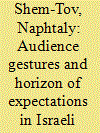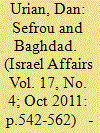| Srl | Item |
| 1 |
ID:
151691


|
|
|
|
|
| Summary/Abstract |
Dennis Kennedy deals with the issue of constructing spectators’ subjectivity, suggesting the term ‘audience gestures’ to explain the complicated behaviour of spectators and focusing on the active bodily dimension of reception (e.g., applause, cheering, booing, hissing). In his view, audience gestures construct the subjectivity of the spectators in terms of social and cultural identities, though they depend on the ‘horizon of expectations’ – the sociopolitical, cultural and aesthetical baggage of the audience. In contrast, this article argues that it is the performance that mostly directs and even programmes audience gestures, which in turn construct the spectators’ subjectivity or identity. By way of exemplifying how the ‘horizon of expectations’ directs the ‘audience gestures,’ this article will discuss audience behaviour in two Israeli theatrical productions – one dealing with secular Jewish identity, the other with Mizrhai ethnic identity – in terms of constructed social identities.
|
|
|
|
|
|
|
|
|
|
|
|
|
|
|
|
| 2 |
ID:
107910


|
|
|
|
|
| Publication |
2011.
|
| Summary/Abstract |
Since the beginning of the 1980s Mizrachi theatre practitioners have confronted the problem of community segregation and the ways in which Mizrachi characters are represented. Gabriel Ben-Simchon and Sammy Michael represent two approaches chosen by playwrights and story-tellers of eastern origins (from Arab countries) in their confrontation with the changes that have taken place among their groups and with the stereotyping of these groups. These two approaches are: anti-stereotyping and specific individualization. Michael has chosen a detailed and intrusive characterization, and his characters feature elements of: beauty, ugliness and, mainly, humanity. In contrast, Ben-Simchon, in his plays and stories, has chosen the anti-stereotype as a paradigm that distances his Moroccan-Jewish characters from reality and sends them soaring into a legendary world. Both these playwrights are fully integrated into Israeli society and culture. They have separated from the past (willingly, or nostalgically), but have not shaken off their Arabic cultural links and preach for a shared future by Jews and Arabs in a modern state.
|
|
|
|
|
|
|
|
|
|
|
|
|
|
|
|